Interactions
Interaction is a small part of your bot. Each interaction carries out one particular task.
When linked together, Interactions create and define the structure of the conversation. It is possible to create complex flows of conversation through the use of Connections.
There are several types of Interaction, each of which has different features. The type of interaction you will want to utilize depends on the type of bot you are creating and the data you would like to gather.
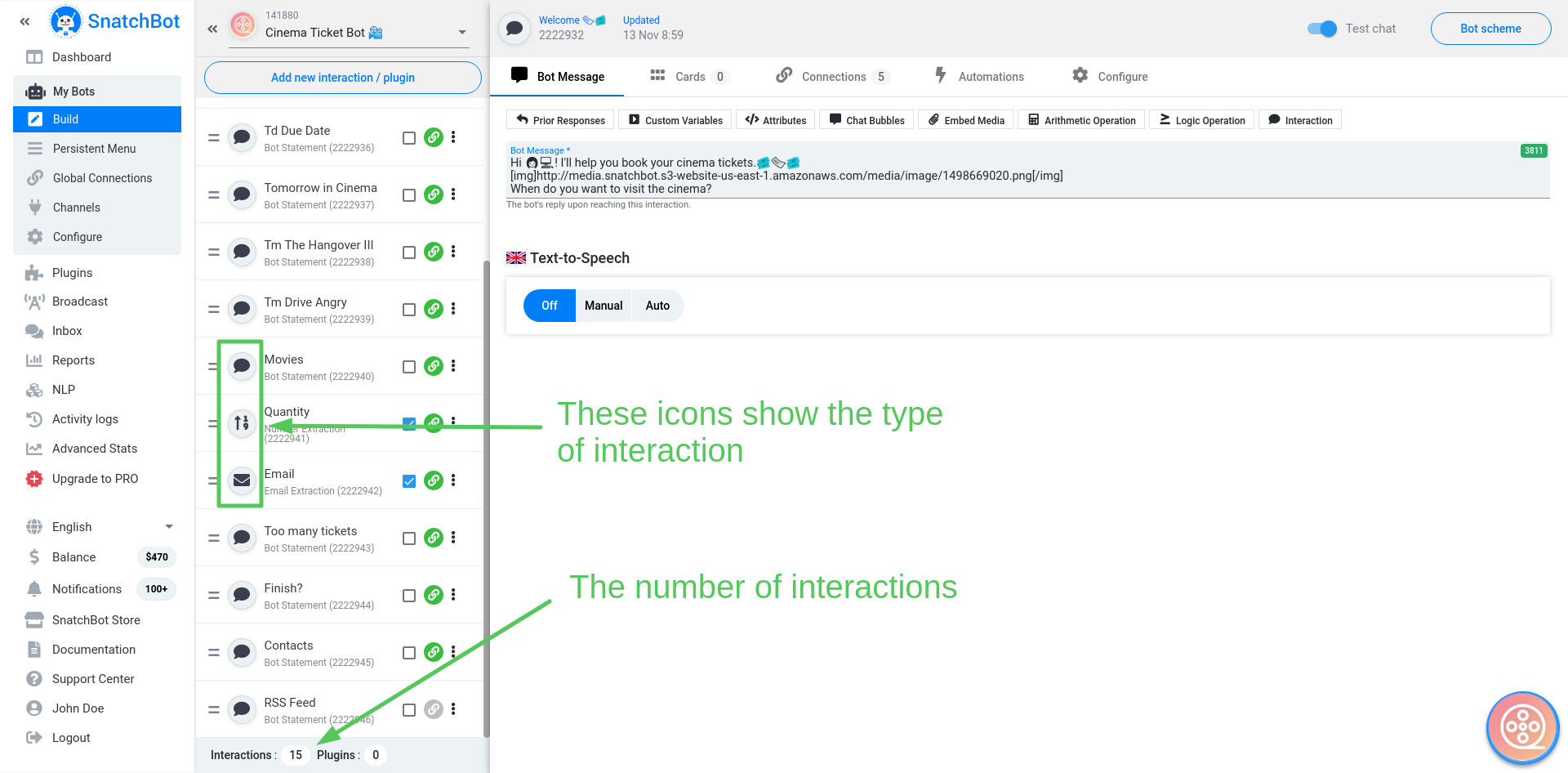
You can add unlimited amounts of interactions and plugins.
Interactions Types
There are 13 types of interactions available.
| Type | Description | |
|---|---|---|
| 1 | Bot Statement | A simple text response that does not involve analysis of a user’s input. |
| 2 | Collect Email | Identifies and collects a valid email address from the input of a user. |
| 3 | Collect URL | Collects a valid URL from a user’s input (https). |
| 4 | Collect Phone Number | Identifies and collects a valid telephone number from a user's input. |
| 5 | Collect Date | Analyzes and extracts a timestamp from the user's input. For example: "1990.12.31" or "02 Jan 1970". |
| 6 | Collect Number | Identifies and collects a number from a user’s input. |
| 7 | Collect Address | Collects and localises a valid address from the input of a user. |
| 8 | Collect Duration | Collects and specifies numeric representations of time, in total seconds with millisecond precision. |
| 9 | Live Agent | The Interaction at which a bot stops responding in order to allow the intervention of a human counterpart. |
| 10 | Translation | Identifies the language of the user and translates it into another language (this Interaction uses the Microsoft API translation). |
| 11 | Search interaction | Allows users to search in Google or Bing right in your bot. |
| 12 | JSON API | Integrates your bot with API. Generates and posts custom content in chat. |
| 13 | Extended API | Only for plugins. The interaction allows you to send API requests and receive data from the third-part services. |
All interactions except JSON contain the Bot Message field. It must be filled, max length = 4000 chars
If you leave the Bot Message or Error Response fields empty, then you will see the warning icon next to the tab:
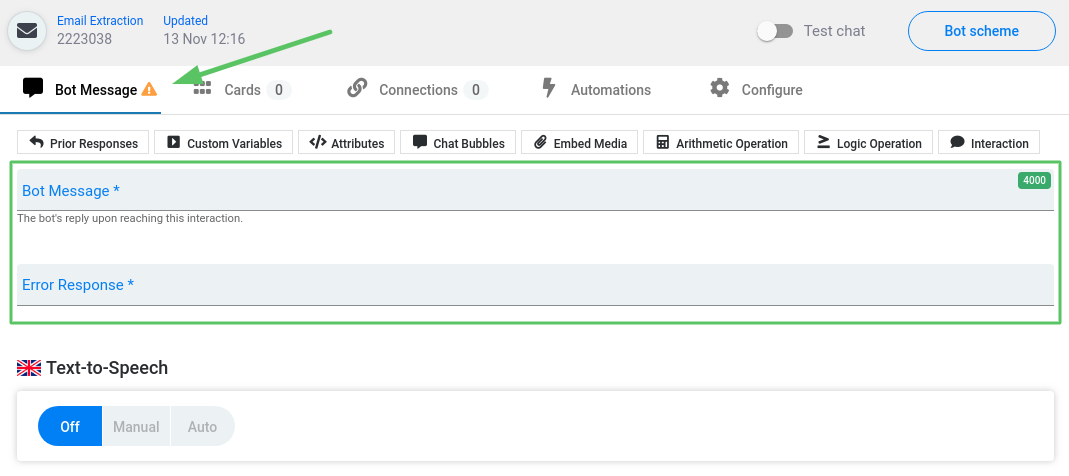
An interaction functionality
Each interaction has a name and unique ID number.
If you check Highlight Extracted Data for a particular interaction, you will be able to highlight important data such as email addresses or phone numbers in the test chat. To do so, you should also press the 'Highlight extracted data' button in the header of the Test chat.
Additional Options
By clicking the 'Additional Options' button the following menu will open up:
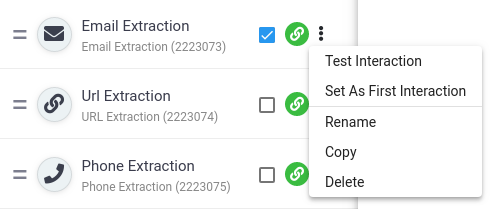
Test Interaction - starts a conversation from the selected interaction.
Set As First Interaction - moves the interaction up to the top of the list. The conversation begins with the first interaction.
Rename - change the name of the interaction.
Copy - duplicates the interaction with all its data and settings.
Delete - deletes the interaction.
There is a connection indicator on the left of the 'Additional Options' button, which will automatically be colored green, gray or red:

Green: the interaction is connected to other interactions. When you hover the mouse over the indicator you will see the tooltip with a list of connected interactions.
Gray: there are no connections from the interaction.
Red: the interaction is connected to a deleted interaction.
If you press the connection indicator, you will be redirected to the Connections tab of the interaction.
Interactions with NLP connections are marked with a special blue symbol:

Interaction settings
This section has many features for the sophisticated functionality of your chatbot. Here you can fine-tune interactions, configure Text-To-Speech (TTS) settings, perform all kinds of logical tasks, connect the current interaction to other ones and test your bot.
Once you have created your first interaction you will get access to these tools:
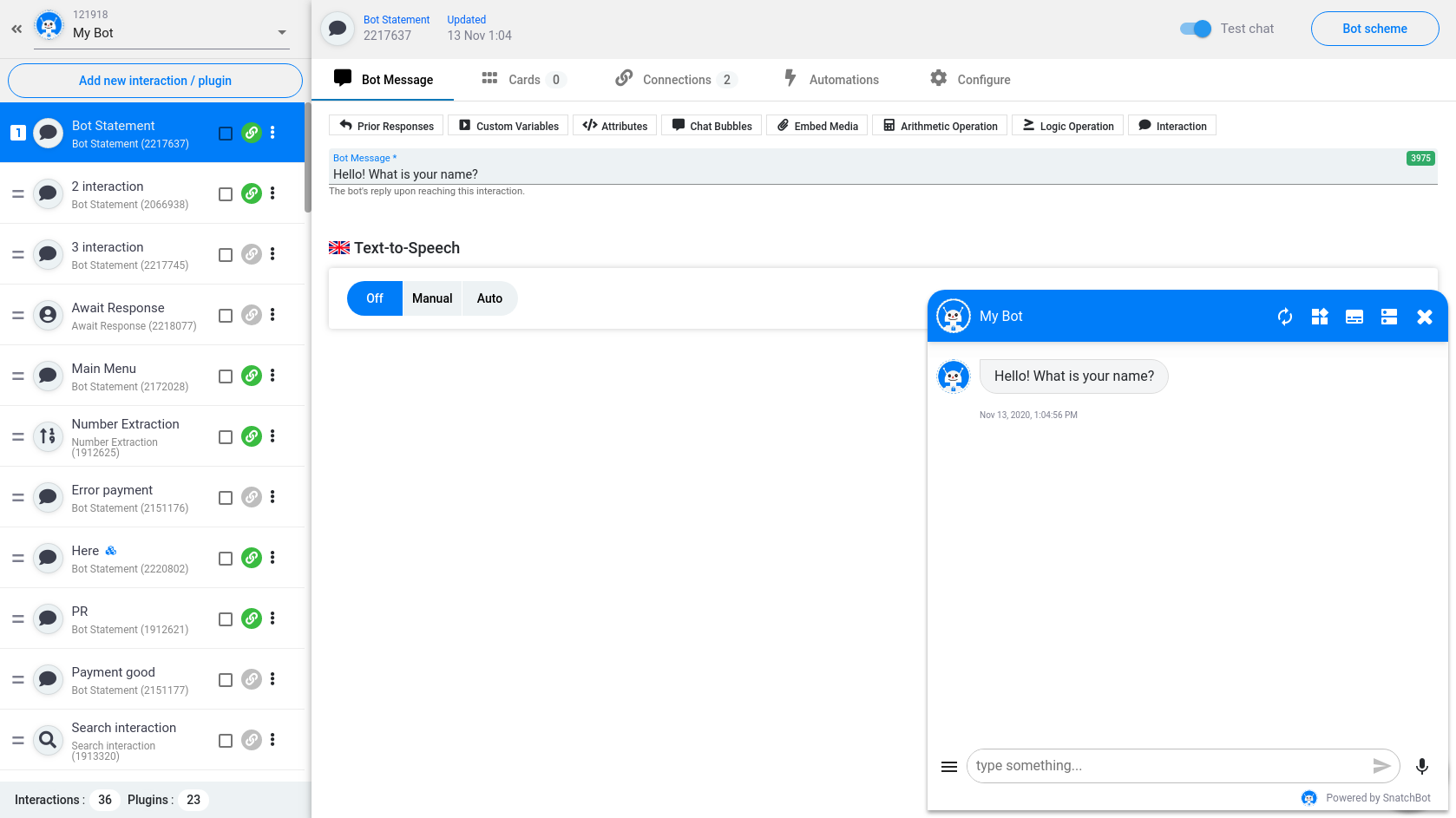
Within the header you will see the following:
- The interaction name, logo and id number.
- The time and date of the last update of the bot
- Test chat toggle: displays/hides the 'Test chat' button that appears in the lower right corner of the screen.
- Bot scheme: opens a bot scheme.
Collection interactions
These interactions detect some information in user responses and save it in a database. Collection interactions also have all the functionality of a regular interaction (cards, QR, connections, etc).
There are 7 types of data available for collection: Email, URL, Phone, Date, Number, Address, Duration.
Collected data can be used in other interactions via Prior Responses or Conditional connections:
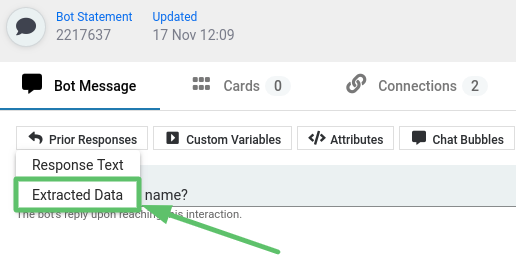
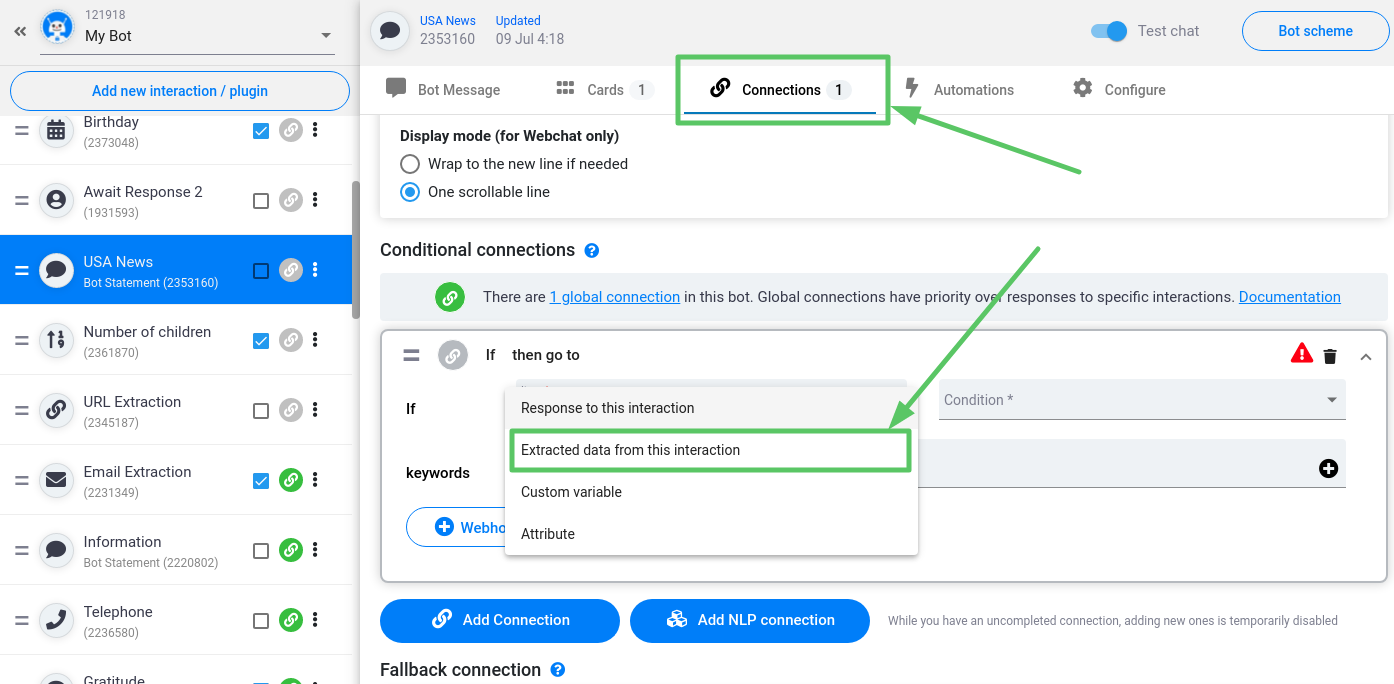
How do Collection interactions work?
Collection interactions (and the Translation interaction) have an additional ‘Error Response’ field in the ‘Bot message’ tab.
Let’s take a look at the Collect Email interaction:
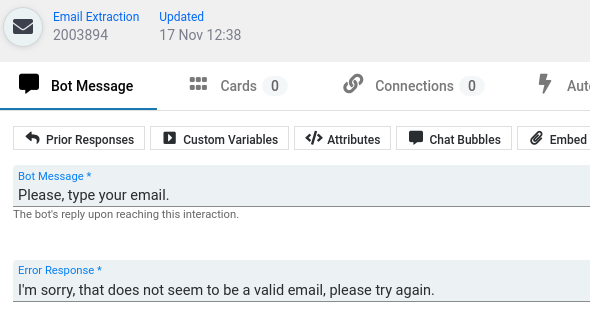
If, for example, an email is expected, but the user mistakenly inputs the email in an invalid format, then the chatbot will give an Error response and ask the user to try again:
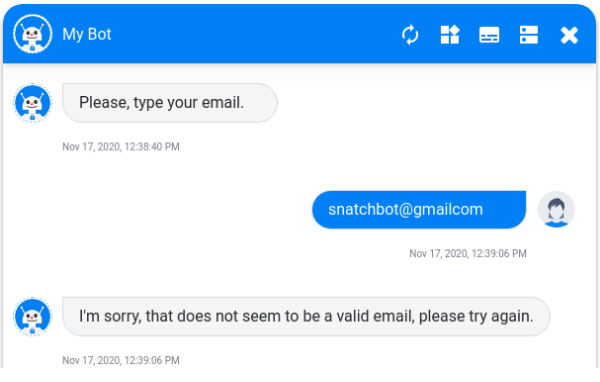
If a user enters a valid email address, then the system will trigger the interaction that is set in the Connections tab. Otherwise, by default, the Fallback connection is set to 'do nothing'. In this case, the bot will give the same message again. If you change the Fallback connection then the system will redirect a user to another interaction after a correct email format has been entered.
The same goes for connections: if you add a simple or NLP connection, and if a user's response is valid and matches the conditions of one of the connections, then the system will redirect a user to another interaction.
Connections settings and Collection interactions
A conversation will not move on a Collection interaction on the basis of a user entry that matches the conditions of the Simple or NLP connection alone. To quit a Collection interaction via a Simple or NLP connection the user’s response must also be a valid type of the selected interaction.
For example, you have a Collect Email interaction and you have set a connection with the following conditions:
- “If Response to this interaction contains (whole word) [email protected] then go to Interaction 1”.
- Fallback is set to “Interaction 2”.
1 Case.
If a user sends “[email protected]” to the bot, then he or she will be redirected to Interaction 1, because this response is valid and matches the conditions of the connection.
2 Case.
If a user sends “[email protected]” to the bot, then he or she will be redirected to Interaction 2, because this response does not match the conditions of the connection. But this response is valid, so the Fallback interaction is triggered. If you set Fallback interaction to ‘do nothing’, then a user will get a Bot message from the Collect Email interaction again.
3 Case.
If a user sends “snatchbot@gmailcom” to the bot, then he or she will get the Error response message, because the entered email is invalid. In this case, the user can send an email again.
For cases in which the system can’t recognize the user’s input after several attempts, you can enable the ‘Custom Error Message’ feature.
Note: Global Connections have priority over Simple and NLP connections and error detection. Therefore, if the user’s response matches the conditions of a Global Connection, the user will be redirected to the interaction that is set in the Global Connection, regardless of the user's input is valid or not.
In order to see the full extracted address in the Test chat, press the 'Highlighted extracted data' button:

Make sure you have highlighted the ‘Highlight extracted data’ checkbox next to the name of the particular interaction in which you want to highlight extracted data:

Where can I find the collected data?
All the collected data is saved in a database on our server. The chatbot owner can access the data on the ‘Reports’ page and apply filters to search the data in a variety of ways. You also have an option to download the data from the server in .xls format.
To make it easier to find collected data in the Inbox and Reports sections you can tick ‘Highlight extracted data’.
The data collected from the Test chat are not stored on the server.
Watch this video tutorial "Interactions"
Updated over 3 years ago
Connections serve as the pipelines between Interactions and control the flow of your bot’s conversation.
